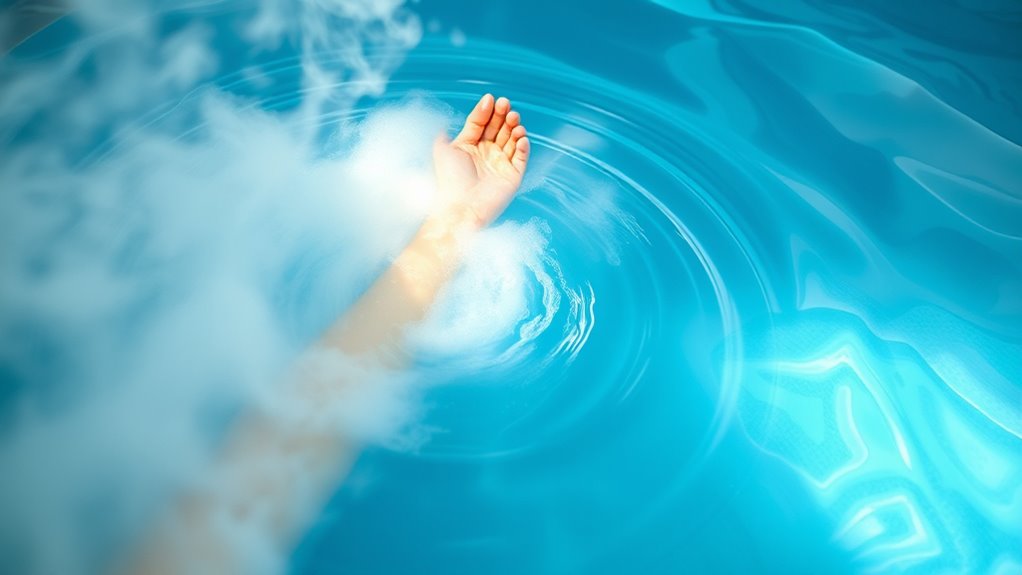Hydrotherapy works wonders because it uses water’s physical properties—pressure and temperature—to promote healing and relief. The gentle water pressure improves circulation, reduces swelling, and eases muscle tension, while warm water relaxes muscles and boosts blood flow. Cold water reduces inflammation and numbs pain. Alternating temperatures and adjusting pressure target specific conditions effectively. If you want to understand how these scientific principles come together to enhance wellness, keep exploring how hydrotherapy benefits your body.
Key Takeaways
- Water pressure exerts hydrostatic force, improving circulation and reducing swelling, which supports tissue healing and pain relief.
- Warm water causes vasodilation, relaxing muscles and increasing blood flow, thereby easing stiffness and promoting recovery.
- Cold water induces vasoconstriction, reducing inflammation and numbing nerve endings for pain management.
- Alternating hot and cold treatments stimulate circulation, enhance healing, and modulate inflammatory responses.
- The physical properties of water are harnessed to target specific health issues, combining pressure and temperature for therapeutic benefits.

Have you ever wondered how water can be used to heal and improve health? The answer lies in the fascinating science behind hydrotherapy, where water’s unique properties are harnessed to promote healing and well-being. When you immerse yourself in water, its physical characteristics, especially water pressure and thermal effects, work together to produce therapeutic benefits that are both immediate and long-lasting.
Water pressure plays an essential role in hydrotherapy. As you submerge, the water’s pressure exerts gentle, uniform force on your body. This pressure, known as hydrostatic pressure, helps improve circulation by pushing blood back to your heart, reducing swelling, and easing pressure on your joints and muscles. It’s particularly effective for conditions like edema or chronic venous insufficiency, where fluid build-up hampers circulation. This pressure also stimulates your nervous system, providing a calming effect and reducing pain sensitivity. When you move or stretch in water, the resistance created by water pressure enhances muscle strength and endurance without overstressing your joints, making hydrotherapy beneficial for rehabilitation and physical therapy. Additionally, understanding the causes and contributing factors of these conditions can help tailor hydrotherapy treatments for optimal results.
Thermal effects are another crucial aspect of hydrotherapy. The temperature of the water influences how your body responds. Warm water, typically between 92°F and 98°F (33°C to 37°C), promotes vasodilation—your blood vessels expand—leading to increased blood flow. This helps relax tense muscles, reduce stiffness, and alleviate pain. The warmth also triggers thermal effects that soothe your nervous system, lowering stress levels and promoting relaxation. On the other hand, cold water therapy causes vasoconstriction, which can reduce inflammation and numb nerve endings, providing relief from acute injuries or swelling. Alternating between hot and cold water treatments can stimulate circulation further, encouraging your body to heal more effectively.
The combination of water pressure and thermal effects creates a powerful synergy in hydrotherapy. For example, a warm water bath with gentle water pressure can relax muscles deeply while improving blood flow, easing pain, and reducing inflammation. Conversely, cold water immersion paired with increased water pressure can help constrict blood vessels, decrease swelling, and promote faster recovery. By adjusting water temperature and pressure, you can target specific ailments or enhance your overall well-being.
Understanding the science behind these effects helps you appreciate why hydrotherapy is so effective. It’s not just about soaking in water; it’s about harnessing water’s physical properties—pressure and temperature—to stimulate your body’s natural healing processes. Whether you’re recovering from injury, managing chronic pain, or simply seeking relaxation, hydrotherapy leverages these scientific principles to deliver impressive health benefits.
Frequently Asked Questions
Can Hydrotherapy Help With Mental Health Issues?
Hydrotherapy can definitely help with mental health issues. When you immerse yourself in warm water, it promotes relaxation, reducing stress and anxiety. You can combine it with mindfulness meditation or other stress reduction techniques to enhance your mental well-being. The soothing effects of hydrotherapy calm your mind, improve your mood, and support emotional health. Regular sessions can make a noticeable difference in managing mental health challenges naturally and effectively.
How Does Water Temperature Affect Healing?
Ever wondered how water temperature influences healing? When you immerse yourself in warm water, its higher temperature increases thermal conductivity, transferring heat more efficiently to your body. Cold water, with its higher water density, helps reduce inflammation and numb pain quickly. By adjusting water temperature, you can optimize healing—hot for relaxation and circulation, cold for inflammation control. Isn’t it amazing how water’s properties enhance your recovery?
Are There Risks for Pregnant Women Using Hydrotherapy?
You might wonder if hydrotherapy is safe during pregnancy. Generally, pregnancy safety depends on the water temperature and duration. Hot water can pose risks like overheating, so it’s best to avoid very hot baths. Prenatal benefits include relaxation and relief from discomfort. Always consult your healthcare provider before using hydrotherapy, and stick to moderate temperatures to guarantee safety for both you and your baby.
How Long Should a Typical Hydrotherapy Session Last?
Picture yourself immersed in soothing water, where comfort is key. For a typical hydrotherapy session, you should aim for about 15 to 20 minutes, ensuring your water temperature stays within a gentle, relaxing range—usually between 92°F and 98°F. Keep an eye on how you feel during the session; if you start to feel fatigued or uncomfortable, it’s best to gently conclude your time in the water.
Can Hydrotherapy Replace Traditional Physical Therapy?
You might wonder if hydrotherapy can replace traditional physical therapy. While aquatic exercise and water massage offer excellent benefits like improved mobility and pain relief, they often complement rather than replace conventional treatments. Hydrotherapy is ideal for low-impact workouts and relaxation, but for certain injuries or conditions, your healthcare provider may still recommend traditional physical therapy alongside water-based methods. Always consult your therapist to find the best approach.
Conclusion
You might think hydrotherapy is just relaxing, but its science proves it’s powerful for healing and wellness. Sure, it might seem too simple to make a difference, but the truth is, water’s unique properties target your body’s pain and stress at a cellular level. So, next time you feel skeptical, remember that science backs hydrotherapy’s benefits—it’s not just soothing, it actually works wonders for your health. Give it a try—you’ve got nothing to lose and so much to gain.









